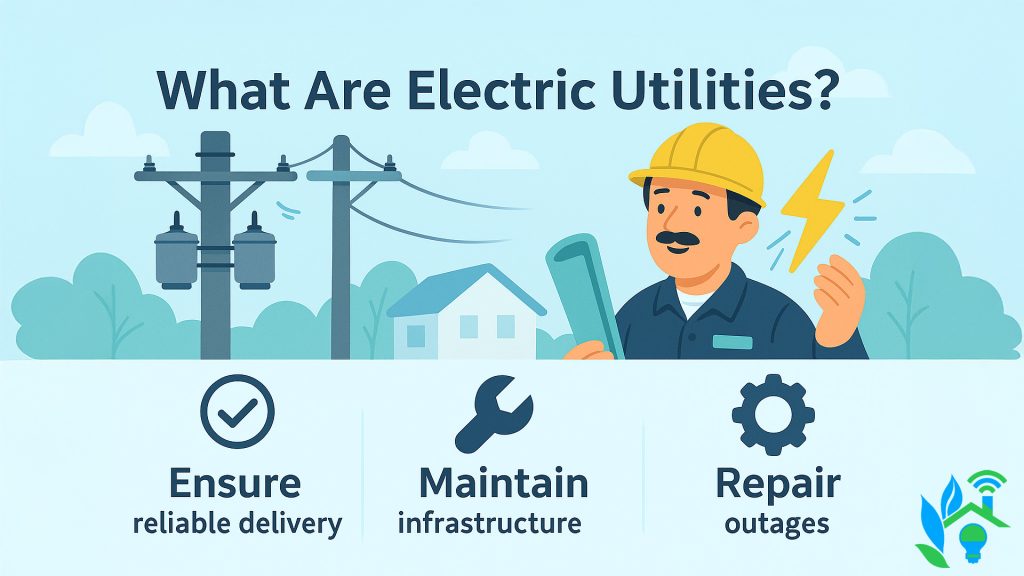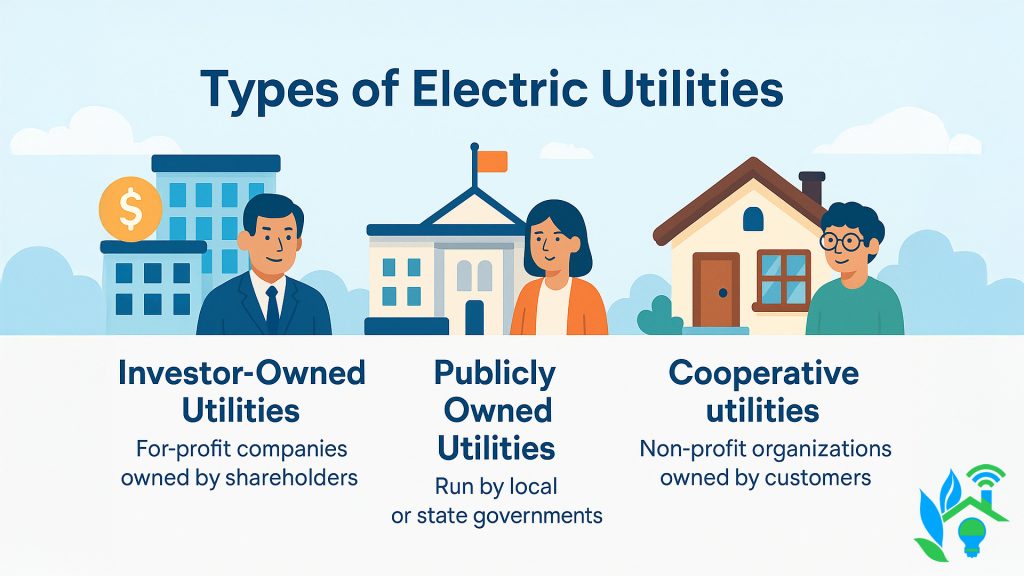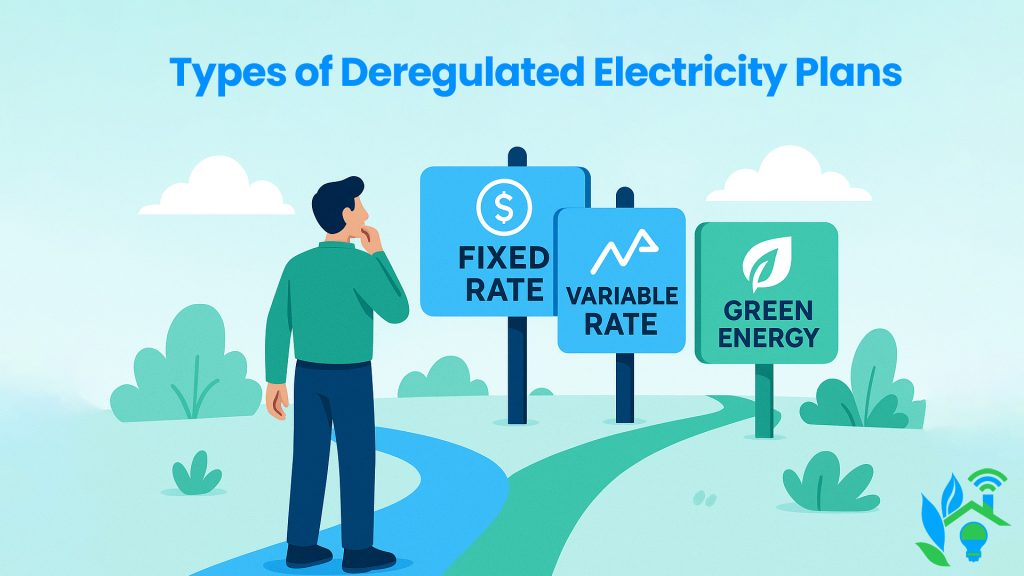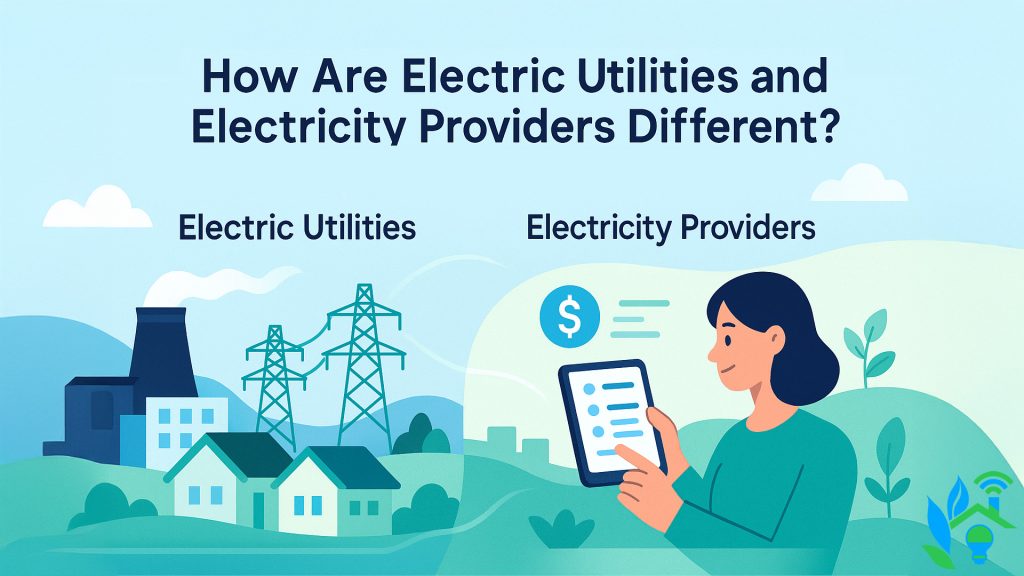Written By: David Cosseboom | Updated On: December 5th, 2025
Electricity powers nearly every aspect of our lives — from keeping the lights on to charging our devices and running our appliances. But did you know that in some areas, you have the power to choose who supplies your electricity? Whether you’re looking for lower rates, greener energy, or more flexible plans, taking control of your electricity options can make a real difference. Let’s explore electricity more together, learn what differentiates utilities from providers, and find out how to supercharge our electricity savings.
What Are Electric Utilities?

Ever wonder who keeps your electricity flowing? Well, that’s where electric utilities come in! Electric utilities are the companies responsible for delivering electricity to your home or business. They’re the backbone of the energy system, ensuring that the power generated from various sources reaches you safely and reliably. Electric utilities handle three key responsibilities:
- Ensuring reliable delivery: Electric utilities monitor the grid to make sure electricity is delivered consistently and safely.
- Maintaining infrastructure: They manage the power lines, poles, transformers, and other equipment that keep electricity flowing.
- Repairing Outages: When the power goes out, your utility works diligently to restore your service quickly.
Coverage Areas
Unlike your local internet provider that chooses where to expand on its own, electric utilities are assigned to specific geographical regions. That means you don’t get the option to choose your utility. Instead, it’s determined by where you live. For example, if you live in Denver, you’re likely to have Xcel Energy, United Power, or CORE Electric Cooperative (all depending on what part of Denver you live).
Compare Electricity Companies for Your Home
Connect Your Home to Water, Electricity, Natural Gas, Internet and Trash services all in one place.
Types of Electric Utilities

Of course, things can’t just be that simple. When it comes to electric utilities, they come in a few different shapes and sizes, including:
- Investor-Owned Utilities (IOUs): These are for-profit companies owned by shareholders. They’re the most common type of utility in the U.S.
- Publicly owned utilities: These are run by local or state governments and serve specific communities. They often prioritize local needs over profits.
- Cooperative utilities: These are non-profit organizations owned by the customers they serve. They’re common in rural areas and focus on providing affordable, reliable service.
Where Does Electricity Come From?
When you plug in your blender or charge your phone from an outlet, electricity may seem the same. However, electricity comes from various sources, including coal, natural gas, wind, solar, and hydropower. Once it’s generated, electric providers step in to deliver it to your home through a complex network of power lines and infrastructure.
Based on the most recent data from the U.S. Energy Information Administration (EIA), fossil fuels provide 60% of the nation’s electricity, while nuclear (18.6%) and renewable energy sources (21.4%) supply the remaining energy. Fortunately, when you choose an electric company in a deregulated market, you can actively decide where your energy originates. For example, you can opt for a provider that offers 100% renewable energy or one that focuses on low-cost traditional fuels — it’s up to you!
Learn more about where the electricity that powers your home comes from
What Are Deregulated Electricity Providers?
While electric utilities dominate energy for most of the U.S., 18 states (and the District of Columbia) allow consumers to choose their own electricity providers through a process called “deregulation.” In deregulated markets, Retail Electric Providers (REPs) are companies that buy wholesale electricity and sell electricity plans directly to consumers. These providers compete to offer the best rates and plans, giving you more control over your energy choices.
- Calculate Your Moving Costs
- Compare Moving Companies
- Get Multiple Quotes
- Move with Confidence
How It Works

When it comes to deregulated electric providers, you can pick the company that best suits your usage, budget, and carbon footprint. So, if you have certain reservations in mind from one provider to another, you can customize your energy journey to meet your specific needs. Here are some different plan options you might encounter when shopping for an electric company:
- Fixed-rate plans: Much like your mortgage, you can select a fixed-rate plan with electric companies to get the best cost based on your usage per kilowatt-hour (kWh). If the rate in your area is already low, it might be worth locking it in for multiple years to get the best price on your electricity bill.
- Variable-rate plans: Do you feel the market is susceptible to more change, or are you unwilling to lock in a rate so you can keep your options open? Many electricity companies offer variable-rate plans where your rate changes. While this type of plan could be beneficial if the rate decreases, it could lead to you paying more later if the rate goes up.
- Green energy plans: If you are motivated by taking an environmentally sound and conscientious approach to your home’s energy, you should consider a green energy plan. These plans are powered exclusively by renewable power sources like wind, solar, or hydropower, enabling you to use and support energy choices that combat climate change.
Benefits of Deregulation

So, why is deregulated electricity any better for you than going with your local electric utility? There are many benefits for your household to choose a deregulated electric provider, including:
- You get different choices to match your needs. In a deregulated market, you have the ability to choose the provider that aligns best with your family. Beyond the fixed-rate and variable-rate plan options, many electricity providers price their plans to align with smaller or larger homes. That means you can choose the provider and specific plan that best fits your home size and family’s electricity usage.
- You save more money because pricing is competitive. Since multiple electricity providers are competing for your business, they have to lower their prices and offer incentives like bill credits to gain the leading edge. That means you can tap into the best possible price for your electricity bill, unlike when you only have one electric utility available.
- You can choose renewable energy. If your consumption focus is to leave the lowest imprint on the Earth, then you can choose specific electricity providers that harness renewable energy sources such as solar, wind, and hydroelectric. While these plans may have slightly higher prices, it means you can align your energy usage with what you believe is most important.
| Licensing and Certification: Providing electricity for people is a major responsibility. That’s why all deregulated electricity providers must be licensed or certified by the state. This process ensures they meet strict standards for reliability, customer service, and fair pricing. |
Who Are the Largest Electricity Providers?
The largest electricity providers in the U.S. include NextEra Energy, Southern Company, and Florida Power & Light. These providers serve millions of customers across the country and offer a mix of traditional and renewable energy options. Explore these electricity providers and the ones near you in the following table:
Find Electric Providers In Your Area
How Are Electric Utilities and Electricity Providers Different?

Okay, so we’ve looked into both electric utilities and electricity providers specifically. However, you might be asking, “How are they different?” Ultimately, it comes down to who generates the energy.
Electric utilities offer a full-service experience, where they are involved in the electricity generation, the management of the services, and the delivery of that electricity to your home. In short, they are a one-stop shop for all your electricity needs. Electricity providers (REPs), on the other hand, tend not to generate electricity. Instead, they purchase electricity wholesale from generators, and then they price that energy for your purchase in a competitive market. Which one is right for you, just depends on what is available near you, your state’s laws, and what you want to achieve when it comes to your home’s energy consumption.
Is Your Area Regulated or Deregulated?
Not all areas in the U.S. allow you to choose your electricity provider. In regulated markets, your utility is also your provider. In deregulated markets, you can shop around for the best plan. The following map gives you an overview of these states and where you can choose a deregulated electricity provider:
States with Deregulated Electric Service

Search for Utilities in Your State
- Select Your State
- Alabama
- Alaska
- Arizona
- Arkansas
- California
- Colorado
- Connecticut
- Delaware
- Florida
- Georgia
- Hawaii
- Idaho
- Illinois
- Indiana
- Iowa
- Kansas
- Kentucky
- Louisiana
- Maine
- Maryland
- Massachusetts
- Michigan
- Minnesota
- Mississippi
- Missouri
- Montana
- Nebraska
- Nevada
- New Hampshire
- New Jersey
- New Mexico
- New York
- North Carolina
- North Dakota
- Ohio
- Oklahoma
- Oregon
- Pennsylvania
- Rhode Island
- South Carolina
- South Dakota
- Tennessee
- Texas
- Utah
- Vermont
- Virginia
- Washington
- West Virginia
- Wisconsin
- Wyoming
- Washington, D.C.
What’s the Right Electric Provider for My Home?

If you do live in a deregulated electricity state, you’ll want to choose the right provider that matches your home and family’s needs. Here are some tips for differentiating between these providers and selecting the best electricity plan for you:
- Look at rates: Since electricity providers have fixed- and variable-rate plans, you should choose which option is best for you. Do you think electricity rates are likely to stay put and the current rate is reasonable for your budget? Then, go with the fixed-rate plan. Are you expecting shifts in electricity rates? Then, select the variable-rate plan for the best savings.
- Check for hidden fees: Many electricity providers are going to require you to sign a contract. That means, if you cancel early, you could face substantial early-termination fees (ETFs) like you would with other home services. Therefore, only sign up for providers that match how long you think you’ll stay in a certain location. Also, watch your energy usage and read the fine print, because some providers will charge you extra for using substantial amounts of electricity over the average home’s consumption.
- Consider green energy: If you want to embrace sustainable living with your energy usage, then you should focus on where the electricity providers source their electricity and choose the ones that are the most renewable. For some people, that means specifically going with a green energy plan for the lowest carbon footprint.
- Read reviews: As the old saying goes, “the customer is always right” — well, most of the time. That said, check out reviews of your local electricity providers to gauge their reliability and service quality. If people are encountering countless issues with particular providers, you might want to choose ones with a better reputation.
Learn More About Choosing an Electric Provider
Other Resources About Electric Providers
Looking for more information about electric utilities, electricity providers, and everything electrical? Stay plugged in and learn more by checking out our other resources about electricity:
- How to Switch Electric Providers
- 11 Tips for Choosing an Electricity Plan
- How to Set Up Utilities For Your New Home
- Understanding Your Electric Bill
- How We Measure Electric Usage
- A Quick Guide to Choosing an Electric Provider
- Tips to Lower Your Electric Bill and Save Energy
- Understanding the Difference Between Fixed & Variable Rates
- Smart Light Switches and Dimmers
- Smart Light Bulbs: Save Energy the Smart Way
- Everything You Need to Know about Smart Thermostats
- Get Assistance Paying Your Utility Bills
Frequently Asked Questions About Electricity Providers
What is an electric utility?
What is an electricity provider?
Who do I call if there’s an outage?
What happens if I don’t choose an electricity provider?
Are there penalties for switching electricity providers?
Can I save money by switching electricity providers?
How can I lower my electricity bill?
– Choose a lower-rate plan in your deregulated electricity market. The quickest and easiest method to getting cheaper electricity is by simply getting a lower cost per kilowatt-hour (kWh).
– Use energy-efficient appliances, including your washer and dryer, hot water heater, refrigerator, and dishwasher. Many people will also employ smart appliances and smart thermostats to maximize their savings.
– Seal windows and doors to prevent heat or cooling within your house from escaping. In fact, the U.S. Department of Energy suggests that this change alone could save you up to 20% per month on your electricity bill.
– Unplug your unused electronics to prevent them from using electricity. Also known as phantom energy or standby power, random electronics around your home could be eating energy and running up your electricity costs.
– Take advantage of off-peak pricing for the lowest rates. Many electric companies have time-of-use (TOU) rates to charge more during peak hours when demand is high. That means you can do your laundry or other electricity-intense activities outside of these windows for the greatest savings.
About the Author
David has been an integral part of some of the biggest utility sites on the internet, including InMyArea.com, HighSpeedInternet.com, BroadbandNow.com, and U.S. News. He brings over 15 years of experience writing about, compiling and analyzing utility data.









